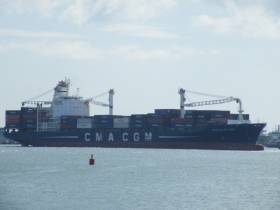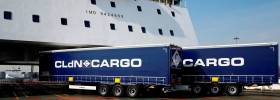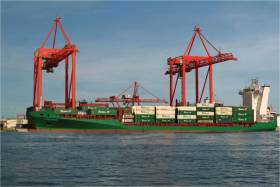Displaying items by tag: Port and Shipping News
#myportforTurku - In addition to Cruise Europe 2016 conference held in Dublin this week, another prestigious annual event is to be held in the capital when the European Sea Port Organisation (ESPO) conference convenes, writes Jehan Ashmore.
The ESPO conference is to take place this week (2-3 June) as previously reported on Aloat.ie As part of the official sponsors, ESPO are to host the #myportinturku photo exhibition at their 13th annual conference to take place at The Printworks in Dublin Castle and hosted by Dublin Port Company.
ESPO will be inviting its members, policy makers and stakeholders to the conference that will look into ways to improve the efficiency of maritime transport and ports from different angles.
The European Commission had announced the 50 winners of the #myportforTurku photo competition following an invite to citizens across Europe to send up to three photos of their favourite ports from Europe with #myportforTurku.
The photo competition was part of the public programme of events held during the European Maritime Day’s (EMD) conference as previously reported on Afloat.ie. The four-day conference took place more than a week ago in the Finnish city on the Baltic Sea.
All the photos were taken over a five day period in April and in which the Commission received 579 pictures, representing 166 ports, from 234 authors from 24 countries. The selected pictures totalling 50 went on display in Turku.
Each winner received a maritime prize (books, free tickets to aquariums and maritime museums, even fish!) from one of the 45 sponsors. Moreover, the attendees of the EMD each choose their favourite picture and the 10 best ones among the 50 exhibited were announced on 19th May.
The 50 selected pictures come from the following ports: Algeciras, Spain; Antwerp, Belgium; Barcelona, Spain; Bilbao, Spain; Callelongue, France; Copenhagen, Denmark; (see picture above: Cork, Ireland); Enschede, Netherlands; Hamburg, Germany; Huelva, Spain; Ibiza, Spain; Kolobrzeg, Poland; Koper, Slovenia; La Coruña, Spain; Le Havre, France; London, United Kingdom; Marsaxlokk, Malta; Newlyn, United Kingdom; Oskarshamn, Sweden; Ravenna, Italy; Rotterdam, Netherlands; Saint-Malo, France; Sète, France; Southampton, United Kingdom; Thorup Strand, Denmark; Trieste, Italy; Turku, Finland; Valencia, Spain; Venezia, Italy; Ventspils, Latvia; Vinjerac, Croatia; Whitby, United Kingdom; Zadar, Croatia.
“We are proud of being the first to host this exhibition. This photo exhibition shows how European citizens are interested in European ports, big and small, and how they see our ports. ESPO has always been putting societal integration high on its agenda. This Commission initiative is certainly a way of bringing citizens closer to the ports”, says ESPO Secretary General Isabelle Ryckbost.
To consult the selected pictures click here and for an interactive map of all the entries click this link.
Shipping Review: Big Ship Craze, Dismantling Dun Laoghaire's HSS Berth, Volumes Up 2% Q1 2016 & More
#ShippingReview - Jehan Ashmore reviews the shipping scene over the last fortnight.
The big ship craze in the short sea shipping industry serving the UK and Ireland has arrived after investment was frozen for the last few years, delegates heard at the Multimodal event in Birmingham.
The annual European Maritime Day’s (EMD) to highlight the importance of the seas, oceans and the challenges facing maritime regions and sectors took place in Turku, Finland.
Sgt. Pepper was among several workboats that called to Dun Laoghaire Harbour to begin short to long term projects. Notably the project to dismantle and remove the former Stena HSS berth.
Port and shipping volumes in the Irish Republic rose 2% in Q1 2016 when compared to the same period of 2015. This is the highest i-Ship index for Q1 of a given year since records began in Q1 2008.
Arklow Cadet is first of a new design of 10 'C' class cargoships for Arklow Shipping nearing completion at Ferus Smit's Dutch yard. The order follows the 'B' class built for ASL by the same yard.
First of New Design ‘Arklow’ Cargsoships from Ferus Smit
#NewCseries - The first in a new class of 10 cargoships for Arklow Shipping under construction near Groningen, Netherlands is to be launched next month and follows a series of a different design built by the same yard, writes Jehan Ashmore.
Launching of leadship newbuild no. 424 Arklow Cadet (also a new name for ASL), a ‘C’ class cargoship with a capacity of over 5,000dwt is to take place at Ferus Smit’s Dutch yard at Westerbroek.
The facility in north-east of the country is where newbuild no. 435 M.V. Ireland was christened (for non-Irish owners) in March as seen in footage previously featured on Afloat.ie. Note on the left of the screen is a green coloured hull mid-section of Arklow Cadet between the builder’s hall and that of M.V. Ireland before launching.
The newbuild represents the first under construction at the Dutch yard for ASL since Arklow Breeze became the final of six ‘B’ class 8,860dwt series. This newbuild no. 414 was launched in March 2015 and entered service the following month. Of the current fleet of 45 cargoships ranging from 4,200-35,000dwt, only 10 vessels date to 2004 or earlier.
Likewise of the Arklow Cadet the ‘B’ class have hulls form chosen to adapt the ‘bulbless’ principle thus creating a slender bow without bulb.
Arklow Cadet has one single hold volume of 220.000 cft. The C class have a 1A iceclass notation and they are propelled by a 1740 kW MaK engine with a single ducted propeller. Delivery of Arklow Cadet is scheduled for July of this year.
Another Dutch yard, Royal Bodewes in Hoogezand which is only several kms away from Ferus Smit continues to roll-out the ‘V’ class series of 10 Eco-Trader 5,100dwt newbuilds. The latest fourth newbuild's stern section was recently removed out of the builder's hall to the outfitting quay.
The V class are managed by Arklow Shipping Nederland B.V. based in Rotterdam and among the bulk dry cargoes they transport they include grain, animal feed and steel rails.
The last completed sister newbuild no. 723, Arklow Valiant launched at the end of March. This week the newbuild was towed down the canal to reach Delfzijl from where sisters have undergone sea-trails.
Shipping Volumes in Irish Ports Up 2% During Q1 2016
#ShippingQ12016 - Port and shipping activity in the Irish Republic rose 2% in the first quarter of 2016 when compared to the corresponding period of 2015.
The figures released are the latest quarterly iShip Index* published by the Irish Maritime Development Office (IMDO). This is the highest i-Ship the index has been in the first quarter of a given year since records began in Q1 2008.
Unitised traffic which consists of Roll-on/Roll-off (Ro/Ro) off and Lift-on/Lift-off (Lo/Lo) traffic continued to rise steadily and has now shown consistent growth for an extended period, with an average growth of 7% per quarter in unitised traffic since Q1 2014 as measured by the i-Ship index.
The majority of Ro/Ro traffic moves between Ireland and Great Britain and this freight segment is a simple but reliable indicator of the level of trade between both economies. Encouragingly, the Ro/Ro freight sector saw volume growth of 7% in the first quarter to 250,287 units. This is the fifteenth consecutive quarterly increase that Ro/Ro has experienced.
Lo/Lo imports have now risen for seven consecutive quarters, reaching 99,303 TEUs. Lo/Lo exports also grew strongly rising 5% to reach 70,551 TEUs. Overall, Lo/Lo container traffic increased by 8% to 169,854 TEUs.
When reviewing Unitised traffic it is worth noting that both Lo/Lo and Roll-on/Roll-off freight moves in an all-Island setting. Therefore when Northern Irish Ports are included, all-island Ro/Ro volume grew by 8% in Q1 2016. All Island traffic in the Lo/Lo sector grew 7% overall, with imports rising 6% and exports 9% for Q1 2016.
The overall bulk traffic segment saw tonnage volumes decrease by 2%, excluding transhipments, when compared to the previous year. This was mainly driven by a decrease in break bulk traffic of 12%; the first year on year decrease in break bulk since Q2 2013. There was a 1% fall in Dry Bulk traffic for Q1 2015, with trade in animal feed, fertiliser and coal affected the most. Liquid bulk (excluding transhipments) also fell marginally, to 2,757,733 tonnes in Q1 2016.
Note: *The iShip index is a volume index for all freight traffic moved to and from the Republic of Ireland. This does not include passengers, and transshipment activity.
Note: All freight and passenger comparisons are done on a quarterly basis (Q1 2015 v Q1 2016)
European Maritime Day's 2016 Held in Turku, Finland
#EMD2016 – The annual European Maritime Day’s (starting today) is to highlight the importance of the seas and oceans and the challenges facing maritime regions and sectors.
This is the ninth edition of EMD and takes place in Turku, Finland with a conference today and tomorrow, 19 May. There will also be an attractive line up of activities for the general public between 20-22 May.
EMD 2016 is organised in cooperation with the City of Turku and the Finnish government. It will take place in an old locomotive hall called Logomo in Turku.
We are looking forward to an exciting and interactive event focusing on the theme of "Investing in competitive blue growth - smart and sustainable solutions".
More specifically it will focus on identifying and highlighting the practical steps needed to drive blue growth investments, as well as innovation and change in the blue economy.
The EMD conference and exhibition offers a dynamic networking environment for the more than 800 participants registered as well as structured opportunities for mutual exchange and debate through 20 stakeholder workshops, five thematic sessions and two 'Leadership Exchange' panels.
The event will also include matchmaking meetings, a networking village with more than 30 exhibitors, a photo competition, site visits, a classical concert, an art project on marine litter and much more.
Afloat adds that last year’s newbuild cruiseship Mein Schiff 4 (pictured above) made a first visit to Dun Laoghaire Harbour last season. The 2,506 passenger capacity was built at the Turku shipyard for German premium-class operator, TUI Cruises. Next week, fleetmate, Mein Schiff I is to call to the Irish port to launch the season on 26 May.
The almost 100,000 tonnes Mein Schiff 4 had anchored off the East Pier Dun Laoghaire Harbour (see photo), became the last order for STX Finland before the Baltic yard was taken last year by Meyer Turku.
Leadship, Mein Schiff 3 was built in 2013 at the same yard. Meyer Turku will complete TUI Cruises order for further sisters.
#BigShipCraze - The big ship craze appears to have spread to the short sea shipping industry serving the UK, after investment in the sector was frozen for the last few years.
However, speakers at this week's Multimodal 2016 event in Birmingham questioned whether there would be enough capacity on the medium term to serve the country’s freight needs.
Richard Horswill, Director of Freight for the UK and Ireland ferry operator Stena Line told delegates: “In the ferry industry we are still recovering from the financial crisis and recession, when volumes fell, which has meant that in the last few years, capacity and demand have become more balanced, but post-recession there has been a lack of investment in ships.”
However, he added that in the last few months, both Stena Line and Belgian ro-ro operator CldN have placed orders for new tonnage.
Stena Line has ordered four Ro-Pax ferries with 3,000 lane metres capacity each with a shipyard in China that are due for delivery in 2019 and 2020, while CldN, which operates the Cobelfret brand, has ordered two enormous ro-ro vessels with 8,000 lane metres-capacity, with an option for a further four.
“More capacity is coming in later, but the question is whether there will be enough capacity to meet market demand in the medium term,” Mr Horswill added.
He also said that whereas today’s ferries are bespoke built for particular routes, the newbuilds the Swedish company has ordered will be far more flexible in terms of trading areas.
“We will be building more ramps at the ports we use, so we can be more flexible about the ships and the way the fleet is deployed,” Mr Horswill said.
However, that trend has yet to be replicated in the lo-lo sector, said Mark Copsey, Chief Commercial Officer at MacAndrews, the UK short sea shipping specialist owned by the CMA CGM Group.
“In the lo-lo sector nobody is investing in new tonnage of the right size, so we are running with older tonnage in the short sea and feeder trades in Northern Europe.
“For the type of service we run, the 800-900 TEU size is the best dimension, but these vessels are also in demand in other markets and are being drained from this region,” he said.
However, fears of potential under capacity in the sectors might not be realised should legislative changes lead to a modal shift away from the sea to road transport.
Richard Newton, Commercial Director of Logistics at the Port of Tyne, said:
“We are very worried that with the forthcoming amendment to the SOLAS regulations with shippers forced to declare the verified gross mass (VGM) of containers, shippers won’t have their VGMs in time to load their boxes on ships, and this could lead them to look for other transport modes, such as road or trains, where they don’t have to declare this information.
“It’s clear that we might lose volumes to road due to this,” he said, adding that carriers themselves need to adopt a common VGM policy.
“Some shipping lines are saying they will have nothing to do with weighing, while others want the ports to do it – from a shipper’s point of view, there needs to be a consistent approach.”
Shipping Review: Tugs Overhaul in Donegal, Fraudulent Certificates, Peel Ports Award & More
#ShippingReview - Jehan Ashmore reviews the shipping scene from among the stories of the last fortnight.
A pair of tugs were overhauled at Mooney Boats, in Killybegs, Co. Donegal, from where supertrawlers based in the premier fishing port will no longer be able to use the larger facility of Dublin Graving Docks that closed in late April.
Department of Transport, Tourism and Sport (DTTAS) has become aware of possible fraudulent Irish seafarer certificates, and fraudulent website, which purports to verify such fraudulently issued seafarer certification.
Croke Park will host the third Atlantic Stakeholder Platform Conference on promoting entrepreneurship and innovation in the Atlantic Area on 27 September.
Owner and developer of Liverpool2 container terminal, Peel Ports Group awarded Logistics Business of the Year at this year's 'Multimodal' in Birmingham. The group operates MTL Terminal in Dublin Port, where Maersk Line has launched recently a new service linking both Irish Sea ports and to Spain.
Irish Continental Group (ICG) has issued Q1 financial results for 2016. Consolidated Group revenue in the period was €91.4m, an increase of 7.4% compared with last year. Net debt at the end of April was €25.9m compared with €44.3m at 31 December 2015.
#Q1figures2016 - Irish Continental Group (ICG) parent company of Irish Ferries, today has issued their Interim Management Statement which covers carryings and financial information for the first quarter of 2016, i.e. 1 January to 30 April with comparisons against the corresponding period in 2015. All figures are unaudited.
Consolidated Group revenue in the period was €91.4 million, an increase of 7.4% compared with last year. Net debt at the end of April was €25.9 million compared with €44.3 million at 31 December 2015.
There has been a good start to the year with trading conditions remaining favourable.
Ferries Division
Total revenues recorded in the period amounted to €51.6 million (including intra-division charter income), a 7.1% increase on the prior year.
In this seasonally less significant period for tourism, Irish Ferries carried 90,200 cars, an increase of 5% on the previous year, while freight carryings were 92,300 RoRo units, an increase of 8% compared with 2015.
The ropax ferry MV Kaitaki remained on charter, operating in New Zealand, while the four container ships acquired in late 2015 were fully deployed in the period.
Delivery of the recently acquired vessel "Westpac Express" is expected by late May. It is bareboat chartered to a third party for a firm period of four months with four further one year option periods and a final seven month option at the Charterer's option.
Container and Terminal Division
Total revenues recorded in the period amounted to €42.3 million, a 13.4% increase on the prior year.
Container freight volumes shipped were up 10% on the previous year at 103,400 teu (twenty foot equivalent units), while units handled at our terminals in Dublin and Belfast increased 54% year on year to 96,500 lifts.
Dublin Ferryport Terminals (DFT) throughput increased by 8% on the prior year.
Throughput at Belfast Container Terminals (BCT) increased by 257% reflecting the additional volumes following the award of the concession to operate the larger container terminal at Victoria Terminal 3 (VT3) which commenced in June of the prior year.
#MultimodalAward - UK based Peel Ports Group, owner and developer of the Liverpool2 container terminal, was recognised as logistics business of the year at the annual Multimodal event held in Birmingham.
The company that also operates the MTL Terminal in Dublin Port (see large containership caller), topped the Exhibitor of the Year category, which recognises business excellence, ahead of other highly commended transport and logistics entries from across the UK.
Now in its ninth year, Multimodal is the UK and Ireland’s premier freight transport, logistics and supply chain management event and is held in partnership with the Chartered Institute of Logistics and Transport and the FTA (Freight Transport Association).
The group, which also owns and operates Manchester’s Port Salford warehouse and distribution centre, was recognised by Multimodal judges for its progressive and innovative approach, as well as for its ambitious development plans across the North-west.
One of the UK’s largest port groups, Peel Ports is currently constructing its £300m landmark terminal expansion project, Liverpool2. (see delivery of giant container gantry cranes). The first phase of the new terminal will be fully operational in the autumn.
Once complete, Liverpool2 will create a state-of-the-art freight gateway as the UK’s most centrally-located, deep-water container terminal and will offer import and export companies located in the North-west of the UK ‘ship-to-door’ solutions via sustainable transport routes such as the Manchester Ship Canal.
David Huck, Port Director at Peel Ports, said: “To be recognised as the Exhibitor of the Year at this year’s Multimodal caps off what has been great 12 month period for the company. With the imminent opening of Liverpool2 and Port Salford we are very much looking forward to the year ahead.
"These annual awards allow the industry to gather and discuss what’s happening in logistics and what the next stages of multimodality are in the pipeline across the UK. It is a great honour to be recognised by our peers as delivering an exceptional business model driving interconnectivity across the country.”
Abbie McGuffie, Multiuser Warehouse Contracts Executive, at Peel Ports was also highly commended in the Young Logistics Professional of the Year category which recognises people under 32 in the industry with a proven track record.
Liverpool2’s waterway connections to Port Salford, as a port centric logistics hub, will also position Liverpool2 as the UK's first "green logistics hub" with the potential to further reduce transportation costs, congestion and carbon footprint for businesses importing and exporting to and from the North West of England.
#GiantCranes – Giant Chinese constructed cantilever rail-mounted gantry (CRMG) cranes arrived by heavylift vessel to Peel Ports Liverpool2 new £300m deep-water container terminal over the May Bank Holiday, writes Jehan Ashmore.
The CRMG cranes, the first of six are to be installed at Liverpool2, the Merseyside quayriver facility (not Liverpool Docks) to berth considerably larger and deep draft containerships. Docking at the port development was heavylift vessel, Zhenhua 25 that set off with the cranes from Nantong,China on the 11,930nm/20,000km voyage to Liverpool.
The 40 day passage of Zhenhua 25, took a route via south-east Asia, India, the Arabian Peninsula and through the Suez Canal before finally completing the voyage to Liverpool last Sunday.
On the opposite side of the Irish Sea, the Peel Port Group are the operators of the Dublin Port container terminal, Marine Terminal Ltd. At the MTL terminal near Ringsend, one of the largest vessels ships to use the facility, Nicholas Delmas (capacity: 2,207 TEU's) departed yesterday.
The Chinese built Nicholas Delmas had arrived from Liverpool from where the new quayside CRMG cranes to be installed having been also constructed by a Chinese manufacturer, ZPMC. According to the Peel Ports Liverpool, ZPMC also supplied the five ship-to-shore cranes already on site at the entrance to the port.
This first batch of CRMG's are the first of 12 required for phase 1 of the terminal. Ultimately the site will have eight STS and 22 CRMG cranes as part of a £100m investment.
The cranes will be capable of performing an average of 20 moves per hour, with semi-automated control linked to the port’s new Navis N4 terminal operating system. They have a 40 tonne under-spreader capacity and a maximum container lift height above quay level of 21m under spreader (6+1 containers).
Liverpool2 is to have a phased opening, with marine trials due to begin shortly and other elements of the semi-automated terminal coming online throughout Q2 of 2016. The first phase of the new terminal will be fully operational in the autumn.






































































